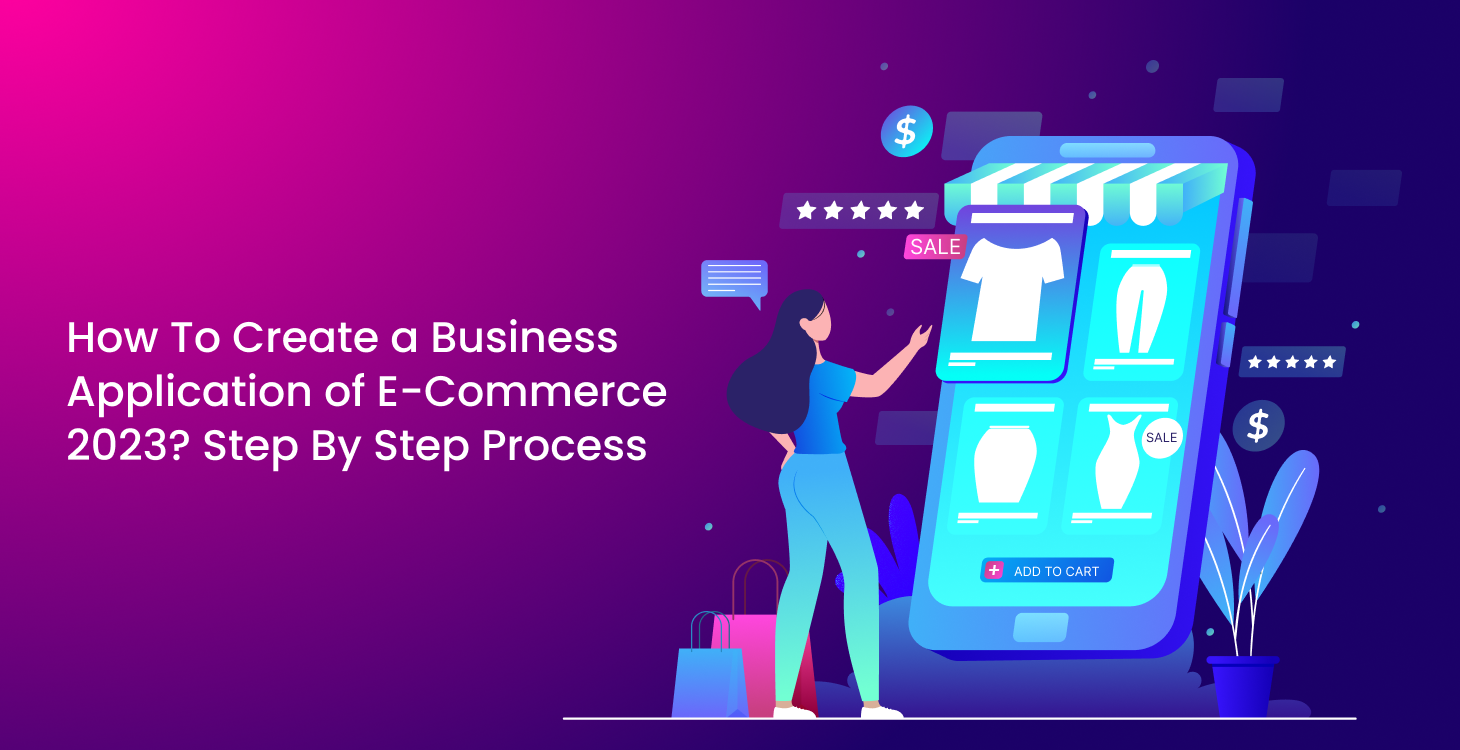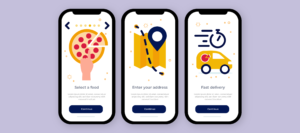How to Create a Business Application for e-commerce 2023? Step By Step Process
Are you an online merchant seeking to have a specific business application for e-commerce? Do you have a great concept for the next popular app?
But how do you go about developing an eCommerce app?
Offering the best possible customer experience is essential for an online store to attract and keep clients efficiently. Connecting with customers on all available contact points and consistently delivering a fantastic experience are the keys to success in this endeavor.
The most crucial touchpoint in today’s hectic environment is a smooth mobile experience. That’s because mobile sales are swiftly catching up to mobile traffic, which currently makes up over 60% of all traffic. Additionally, 80% of customers browse the store’s mobile website while in the physical location.
Using the examples of several global giants like Amazon, Domino’s Pizza, McDonald’s, and even Starbucks, we can see how m-commerce or an e-commerce application has helped these large businesses improve the consumer experience. Although there is huge conflict among well-known corporations worldwide, that does not imply that prospects are scarce in this field.
But how can you develop a successful mobile ecommerce app for various industries that attracts more customers, sales, and one-time buyers? Read on to learn the precise steps of business application for e-commerce that we’ve done with more than 1,000 brands.
What is an e-commerce Business?

Ecommerce refers to a business model where products or services are purchased and sold online. Ecommerce companies will carry out these online transactions by digitally transferring money and data.
In other words, an online marketplace called e-commerce allows buyers and sellers to transact with customers to exchange products and services. The terms “business to business” (B2B) and “business to consumer” (B2C) ecommerce are used frequently. While B2C vendors concentrate on selling goods to consumers, B2B vendors concentrate on selling goods that other businesses may need (or the end customer).
If you’re a talented businessperson or craftsperson, you have thought about opening your online store and creating a company that provides freedom and success. In this guide, you’ll learn every step.
Step by Step Process to Build a Business Application for e-commerce

1. Come up with the app idea:
Deciding on an idea is the first step in creating an business application for e-commerce rather than writing code. Before starting the coding, having a solid app idea can help you save thousands of dollars. Additionally, it can prevent you from submitting an application that nobody wants.
The app development cycle needs to be short, which is another crucial factor to consider. Making a Minimum Viable Product should take a few months to begin with. It’s crucial to realize that to determine what features are necessary to make a successful app, real-world data and user feedback are required.
The ideal approach to continue before an app developing process begins is with a well-written business plan.
2. Understand your target audience:
Consider who your audience is once you’ve determined what you want to achieve. Not only that, but B2B clients may require a different experience than B2C clients. Knowing who your target market is will help you design your business application for e-commerce more quickly and advertise it more effectively.
Inquire about things like:
- What is the typical age of my audience?
- What are their areas of interest?
- Which products do they already like and purchase?
- How have they found us?
The ecommerce app you develop will take on the characteristics of these queries and your particular area of expertise.
For instance, a B2C fashion retailer may use lookbooks and App Store Optimization to market to a certain clientele. Likewise, a retailer with physical locations may seek to discover a way to link its online and offline touch points.
After selecting your target audience, proceed and…
3. Choose the right platform:
Before choosing what technology to utilize for business application for e-commerce development, We suggest you become familiar with the inner workings of your company. Then, keep an eye on your inventory and development costs, and choose a scalable framework, database, and content management system.
This knowledge makes it much simpler to choose whether to release an iOS app, an Android app, or both. You must focus on the mobile platform used by your target market.
The tech stack is a crucial requirement to transform a fantastic idea into a profitable product. The term “tech stack” refers to a collection of parts, such as:
- Frontend (the app’s user interface);
- back-end (server-side processing);
- a platform for development (with libraries and interfaces);
- supporting (technology that offers the performance and security of the app).
4. List down the essential app features:
The next step in creating a business application for e-commerce is to create a shortlist of all the necessary features. Then, find and outline the features that will make you stand out from competitors. Check out the list of features below for a start:
- Push messages: Push messages are essential to every contemporary e-commerce app.
- Wishlists: Wishlists are popular with both B2B buyers and B2C retailers. The rationale is that B2B clients frequently make further transactions so that clients can make repeat purchases much more quickly through a wishlist.
- A review/rating system: Customers use reviews and rating systems to assess products they might purchase. It is usually a good idea to provide a method for users to accomplish it within the app.
- Multiple relevant payment options: It’s crucial to provide all payment forms accepted in one’s target nations.
- Custom branding and design elements: This enhances a brand’s reputation and an app’s overall appearance.
- Social media integration: Social media integration can be beneficial, particularly if you are trying to reach millennials and younger generations.
- Native experiences: Last but not least, your app will benefit from features like swipes, taps, and touches, as well as from making the best use of the available screen space.
Make a list of the must-have features, and then go to the next phase.
5. Design UX/UI interface:
As we said before, UX&UI design offers the chance to distinguish because the experience in eCommerce apps needs to go beyond traditional in-store buying. The design will communicate your brand’s voice and identity to your target market. Customers are left with a lasting impression of your business when you use appealing color schemes, eye-catching graphics, and seamless page transitions.
6. Set a budget for developing your app:
Now that you have all the items ready and wish to prepare the meal, it is time to do so. First, it would help if you thought about your budget and development to ensure your app’s success. You must be aware of the time, money, and resources your business application for e-commerce will require. To learn more about this, speak with an eCommerce or Android development company.
7. Develop MVP:
Do you recall when we mentioned the product aspects that should come first? You must concentrate on the most important elements of your business application for e-commerce during the MVP stage. Instead of launching a finished product straight immediately, we suggest doing ongoing product evaluations that drive new revisions.
MVP attempts to discover what customers think of the product, shorten development time, lower risks, and more effectively employ resources.
8. Perform SEO for your app:
Using SEO effectively can help your app rank higher than your competitors in the app stores for mobile platforms. A better ranking makes it easier for users to find your app.
A well-optimized app with a strong SEO or ASO rating may be useful. The following elements have an impact on how mobile eCommerce apps rank in search engines:
- Title
- Backlinks
- Keyword
The number of downloads, ratings, and reviews are additional elements that affect app rankings after release. By gratifying users from the beginning, these factors can be optimized in the greatest way possible.
9. Publish your eCommerce app:
The stage in creating a business application for e-commerce is to publish it on various mobile app stores.
Compared to the Apple Store, creating an app for publication on Google Play is much simpler. First, examine the variations in how apps are published in each app store.
Google Play Store
- Sign up for a Developer Account
- Create a title and description for your app
- Set out the content rating
- Specify app pricing
- Wait for the automated review
Apple Store
- Sign up for a Developer Account
- Pay the yearly $99 subscription fee
- Upload the application
- Submit your app for a review
10. Gather Feedback:
When the MVP is made available, it’s time to start getting customer feedback. Checking user interaction with your app, gathering user input, and looking for potential changes are all part of the process. Gathering user feedback is important when creating e-commerce applications since it enables you to determine what appeals to and repels your target market.
How much Does it Cost to Create an eCommerce Business App?

The internet will give you a tonne of pricing estimates when you search for how much it will cost to design an eCommerce app. But, the real concern is whether or not those estimates are reliable enough. How well do those predictions match actual costs?
According to a recent study by GoodFirms, the average cost of creating a straightforward app can range from $38,000 to $91,000. But there are basic, standard, and complex versions, which vary in the degree of technical assistance required as well as how sophisticated the functionality of a business application for e-commerce is. The final cost could also depend on several other elements. Therefore, you must choose whether to create an MVP first and create apps for the iOS and Android operating systems simultaneously or separately. It would help if you also decided whether you want to hire software experts on-site to develop your app or outsource it. Let’s now look at how much it can cost you to create a native eCommerce app for Android and iOS.
| App Types | iOS app | Android app |
| Basic app | $35,000 | $30,000 |
| Medium-complexity app | $50,000 | $50,000 |
| Complex app | $100,000+ | $90,000+ |
So, this is a better estimate of how much it costs to develop an app. But many of you are curious as to why there is such a significant difference between each version of the app and what specifically influences the price of developing eCommerce software.
Many things affect how much it costs to design an app, but the main one is the kind of app you want for your company.
Final Words
As the e-commerce market offers many prospects for expansion, it’s the best time to launch your business and spend money on an ecommerce app to help your growth.
To get your app idea off the ground, you must work with a mobile app development company with experience converting app concepts into live mobile applications by integrating cutting-edge technology and demanding features.
After reading this blog, you will better understand how business application for e-commerce have grabbed the market’s interest. Get in touch with us if you have a connected app idea and need professionals to assist you in carrying it out as you had imagined.
FAQs
Question 1: When launching your e-commerce app, should we target the iOS or Android platforms?
Previously, businesses might have created apps that exclusively supported a specific platform. However, most businesses today seek to create apps that work on both the IOS and Android platforms because they currently have significant market shares.
Question 2: Is the eCommerce industry profitable?
Yes, running an online store may be highly lucrative. However, for results to become apparent, patience is required. A thriving eCommerce business can be established in as little as six months or as long as two years. But, of course, the timing varies depending on your methods to drive traffic to your website.
Question 3: How much does it cost to create an e-commerce app?
The typical cost to design an ecommerce app would be between $25,000 and $30,000. However, the price of creating the app will increase to $35,000 if AI and customized features are integrated.
Question 4: What steps are involved in making a mobile app?
Mobile app development is creating software applications for various mobile devices. To construct a mobile app, you must pick a company with experience with a range of mobile apps and adhere to a tried-and-true development process.
Question 5: Is it too late to launch an eCommerce business app?
It’s always possible to launch an online app since, as online shopping continues to grow, so will the online store sector. You can start immediately, but it will take time to see the benefits.




